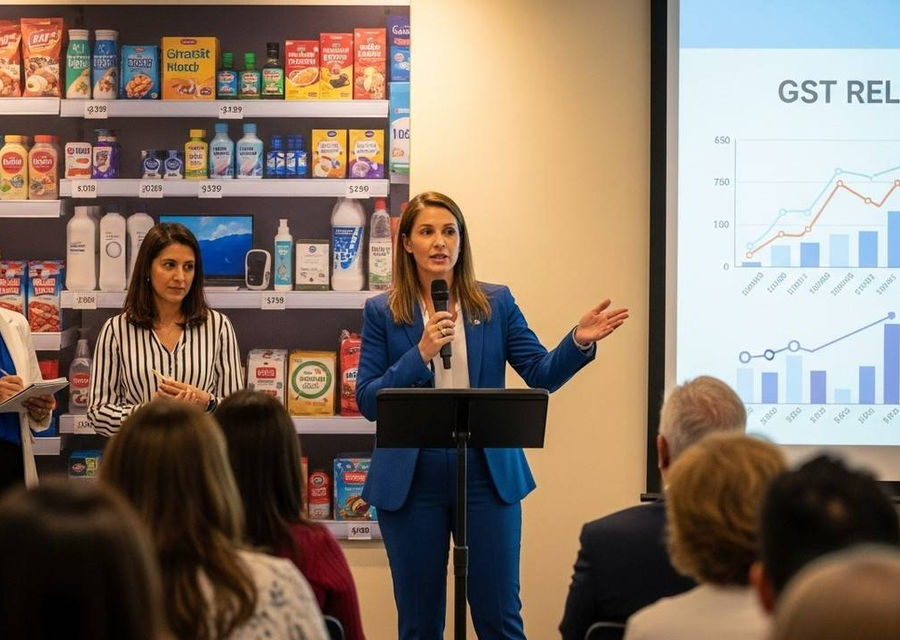GST anti-profiteering framework and price relief: how Indian shoppers could gain from rate cuts
- THE MAG POST

- Sep 8
- 3 min read

GST anti-profiteering framework reshapes how governments monitor price discipline after tax relief, and its promise hinges on transparent pass-through to consumers. This analysis examines the push for price transparency, the roles of the GST Council and GST Appellate Tribunal, and the practical tensions between enforcement and business flexibility. It also considers how industry might respond and what signals help buyers trust that relief reaches shelves rather than profit pockets. The GST anti-profiteering framework, as a policy concept, remains a focal point for design, balancing consumer welfare with enterprise dynamics as market players adapt to evolving rules.
It also considers how industry might respond and what signals help buyers trust that relief reaches shelves rather than profit pockets. The GST anti-profiteering framework, as a policy concept, remains a focal point for design, balancing consumer welfare with enterprise dynamics as market players adapt to evolving rules.
Policy push: price relief and consumer protection in focus
Governments aim to turn tax relief into visible consumer savings, and the path hinges on credible checks that deter profiteering without strangling commerce.
This section surveys the push to ensure rate cuts translate into lower retail prices, the roles of the GST Council and GST Appellate Tribunal, and the practical tensions between enforcement and business flexibility. It also considers how industry might respond and what signals help buyers trust that relief reaches shelves rather than profit pockets. The GST anti-profiteering framework, as a policy concept, remains a focal point for design, balancing consumer welfare with enterprise dynamics as market players adapt to evolving rules.
Historical context and institutional shifts
The National Anti-Profiteering Authority (NAA) operated from 2017 until late 2022, rooted in Section 171 of the CGST Act. It suffered procedural delays and a punitive perception, which tempered trust in the regime. The shift of responsibilities to GSTAT marked a pivot toward adjudication by a specialized tribunal.
In 2024, the GST Council signaled that no new anti-profiteering cases would be accepted by the CCI from April 2025, signaling a major governance transition. Analysts debate whether a refined, sector-specific framework could sustain consumer gains while minimizing red tape and litigation risk.
Industry response, consumer impact, and best practices
Industry responses and practical implications shape the near-term trajectory of relief implementation. In practice, pass-through depends on competition, supplier terms, and macro conditions. Some categories may see swift price reductions, while others lag due to logistics or brand positioning. Transparent data collection and periodic updates can strengthen confidence that relief is passing through to shoppers.
Retail dynamics may favor service and quality improvements over uniform price cuts, complicating simple pass-through narratives. Clear communication about what tax relief covers helps consumers understand benefits, while firms retain flexibility to optimize value through non-price dimensions such as reliability and experience. Best practices focus on measurement clarity, credible benchmarks, and independent audits. Public dashboards, along with real-time price tracking, provide accountability without imposing excessive administrative burdens on businesses.
Key Takeaways
The core aim remains ensuring tax relief translates into tangible savings for shoppers, supported by transparent rules and timely action. The path forward hinges on credible enforcement, robust data, and ongoing dialogue with industry partners.
As debates evolve, speed, fairness, and simplicity will determine whether a formal framework strengthens welfare without constraining enterprise agility. Ultimately, consumer welfare and market efficiency can be enhanced when authorities provide clear methodologies, expedite decisions, and maintain proportionality to risk. A balanced approach aligns regulatory rigor with the realities of business timing and competition.
Aspect | Summary |
Policy aim | Directs industry to pass GST relief to consumers and monitor profiteering; focus on transparency. The GST anti-profiteering framework informs monitoring. |
Institutions | NAA (historical), GSTAT, CCI; potential GST 2.0 options. Evolving governance structures shape enforcement and guidance. |
Enforcement | Potential formal framework, faster adjudication, public dashboards. Aims to deter unjust pricing while preserving competitiveness. |
Outlook | Industry collaboration expected to shape pricing, with care to preserve pricing autonomy. Transparent data drives accountability. |






















































Comments